Trucks of the Future… but from the Past
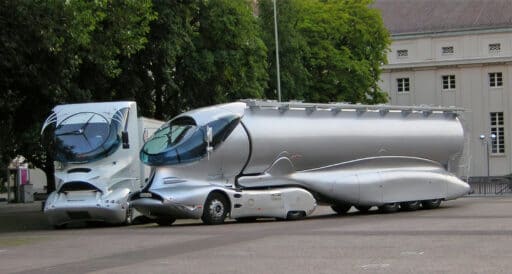
The history of trucks and semi-tractors is filled with projects that seemed innovative or futuristic at first but ended up only as interesting side notes. Even though these vehicles didn’t make a lasting impact, they showcase the creativity and forward-thinking of their inventors. Here, we highlight five trucks that were considered cutting-edge when they first appeared.
Dodge Airflow Tanker
In the 1930s, the directions in which the future of the automotive industry was to go were set rather by stylists than engineers. Of course, successive technical innovations were introduced, there were automatic transmissions, front-wheel drive, and engines received additional pairs of cylinders (American Cadillacs were then driven by powerful V-engines that had as many as sixteen cylinders). However, for the most part, cars (and trucks) at that time remained conventional from the technical point of view. The look towards the future was supposed to be expressed by their bodies. Designers, working both for automotive companies and for specialized coachbuilders, began designing more streamlined bodies in line with the then-prevailing trend of art deco (or streamline moderne). Attention was paid to the fact that the greater the air resistance a car faces, the worse its performance on the road and the more fuel it will consume. Engineers at the Chrysler Corporation noticed that most of the cars sold at the time encountered less aerodynamic resistance when driving backwards. The company decided to introduce a revolutionary car: the Airflow model. It hit the market in 1934 and was distinguished by a more streamlined silhouette than its competitors (rounded hood and headlights moved from the front fenders into the body contour). Chrysler’s Airflows (also available under the DeSoto brand) were a breakthrough, but they were ahead of their time, so they failed in the market. They were only produced until 1937, and in the meantime, the front was restyled to better meet the tastes of the conservative clientele. However, there was no turning back from aerodynamics of bodies, as shown by subsequent decades of automotive development.
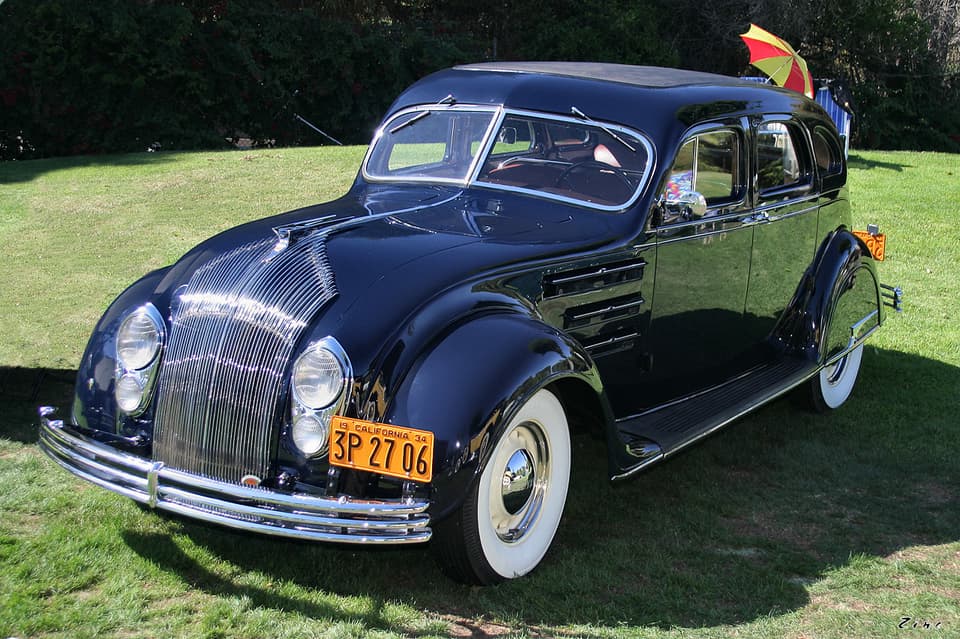
1934 Chrysler Airflow Sedan (Author: Rex Gray, CC BY-SA 2.0, Wikipedia)
Chrysler wanted to introduce aerodynamic modernity to the commercial vehicle market as well. In the same year as the passenger Airflow, a truck of the same name debuted on the market, offered under the Dodge brand. The design, especially compared to trucks from other American manufacturers, was absolutely unique –the driver’s cab looked like an enlarged passenger model. Airflow trucks were offered as tankers for transporting fuel and beer. The former were ordered by the oil companies Texaco and Esso, the latter by the Schlitz brewery. The bodies for transporting liquid cargoes were made by specialized companies and in this case, the design also followed the spirit of modernity –the streamline moderne influenced tanks formed a straight line with the roof of the driver’s cab. Especially the model used by Texaco, painted entirely in red, with a large white “TEXACO”inscription on the tank must have made a huge impression on the observer. And construction-wise? Well, there was no revolution, as under the streamlined body hides a standard truck from Dodge’s offering. The Airflow for fuel transport was available on special order and throughout the production period went to only 265 customers. Interestingly, it survived on the market three years longer than its older, smaller, passenger brother.
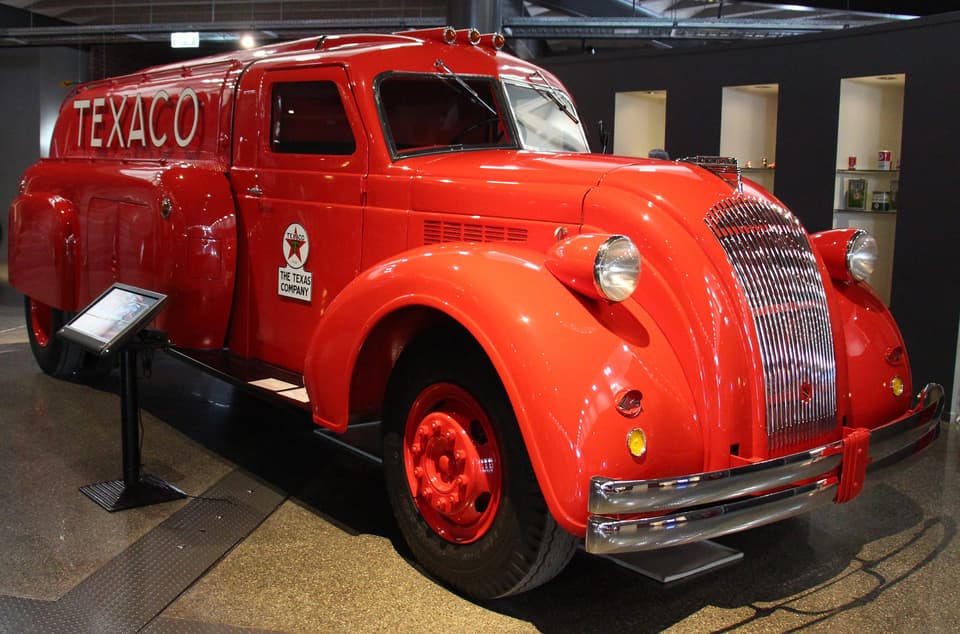
Dodge Airflow Tanker (Author: Sam Butcher, CC BY-SA 2.0, Wikipedia)
Texaco Doodlebug
In the 1930s, Texaco oil company wanted to refresh its image and for this purpose hired Norman Bel Geddes, a well-known industrial designer. It was then that the famous brand logo was created (the letter T inscribed in a five-pointed star), which is still used today. The Texaco management decided that the symbol of the brand’s development would also be the modernization of their tanker fleet and giving it a futuristic flair, and in the third decade of the 20th century, modernity had one name: streamline moderne. Dodge Airflow tankers were purchased, as you could read above, but Texaco did not want to stop there. The decision was made to develop a true tanker of the future, and Norman Bel Geddes was to design it.
The technical side of the project was handled by the truck manufacturer Diamond T, which provided the chassis with a rear-mounted six-cylinder Hercules engine. Today, looking at the final result of Bel Geddes’and Diamond T’s work, it’s hard to believe that this vehicle was created in 1934. The driver’s cab and fuel tank were integrated and form one unit, resembling a half-cut cylinder rounded at both ends (or a loaf of bread or sausage). There were no typical truck protruding hoods, fenders, and bumpers of that period. The front windshield was made of bent glass, which at the time was still a novelty in the automotive industry. Since the engine was placed at the back, and the fuel tank (1500 gallons) was located between it and the driver’s cab, it was necessary to install a microphone in the engine compartment and a speaker in the driver’s cab, so the driver could hear the engine running and knew when to change gears. But that’s not the end of the list of features that distinguished this unique vehicle, popularly known as the Texaco Doodlebug, because this truck was only 1.8 meters tall, the same height as the passenger cars offered in the USA at the time. Compared to its competitors, it was compact in size. However, the Doodlebug remained just a curiosity. It never went into mass production, nor did it become the main workhorse of the Texaco tanker fleet, as only six units were made (supposedly none have survived to our times). The Doodlebug was intended to be merely a show vehicle, a proof that the oil conglomerate from Beaumont, Texas, was moving with the times. In terms of the development of commercial vehicles, it was therefore a dead end. But what an unusual dead end it was.
GM Futureliner
Equally unusual is the next hero of this article. It has much in common with the Doodlebug: the period of production, the design, the small number of manufactured units, and the purpose of existence, which was to showcase the construction capabilities of the manufacturer. Behold the General Motors Futureliner!
At the beginning of the 1940s, General Motors inaugurated a great traveling exhibition called the Parade of Progress, dedicated to the latest technologies in industry and scientific achievements. From 1940 to 1941, the mobile exhibition traversed the United States from coast to coast, with about 150 stops;the project was then repeated from 1953 to 1956. The heart of the Parade of Progress was twelve specially prepared trucks named Futureliners (an ideally chosen name, isn’t it?) –each powered by a four-cylinder diesel engine (in the 1950s, they were replaced with six-cylinder gasoline engines paired with automatic transmissions). Futureliners were 10 meters long and 3.5 meters tall. The driver sat in the middle of the cabin (alongside two passengers) at a height of about 3 meters. A special feature of the Futureliners was the use of dual tires not only on the rear but also on the front wheels. The futuristic, according to the standards of the 1940s of course, body design was overseen by Harley Earl –one of the most famous American car designers of the 1950s, considered the father of “fins”(or “tails”) –symbols of Yankee automotive of that era.
Each Futureliner served as a mobile exhibition point –inside it was equipped with exhibits dedicated to a selected topic in the field of technology or science (jet engines, television, car production, modern farming methods, etc.). The twelve Futureliners moved in a convoy (accompanied by dozens of support vehicles);upon arriving in the next city on the route, a large tent was set up, which served as the central point of the exhibition, around which parked Futureliners were ready to welcome visitors.
Today, about 9 Futureliners out of the 12 produced have survived (they are in museums and private collections). The special trailers used today by many companies as mobile exhibition stands or showrooms continue the legacy of these unique vehicles. However, they are no longer as unusual in terms of design –they are just ordinary trailers with special equipment, pulled by standard tractor units.
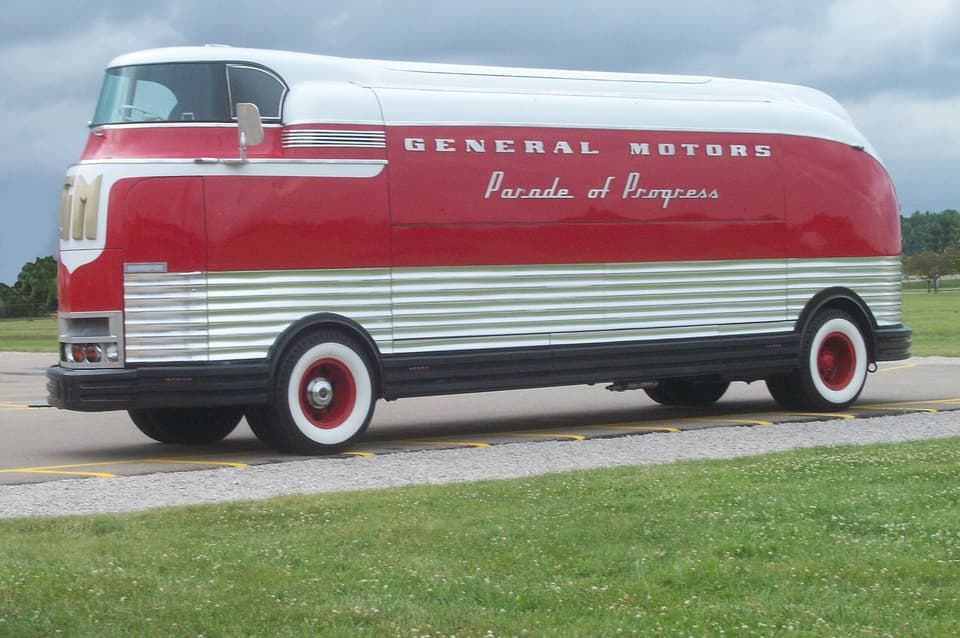
GM Futureliner (Author: Binelli2011, CC BY-SA 2.0, Wikipedia)
Colani “Space Truck”
Luigi Colani (real name Lutz Colani), who passed away five years ago, was a German automotive designer;he designed for Fiat, Alfa Romeo, and BMW. However, cars were not the only object of his professional interest, as he also worked on the design of tv sets, pianos, and even pens. His designs were distinguished by rounded, almost organic forms, which are also present in his most famous work, created in 1977. It was then that Luigi Colani presented a prototype of a future semi-tractor, which the automotive press quickly (and rightly) dubbed the “Space Truck”.
The design, even today, over 40 years later, looks fresh and futuristic. The cabin of the tractor has the form of a sort of capsule, and the shape was supposed to provide as much aerodynamics as possible (Colani himself stated in interviews that his idea was a response to rising fuel prices during the energy crisis, but at the time no one paid attention to it). Undoubtedly, the most characteristic element of the design is the ring-shaped windshield wiper, which looks a bit like the Mercedes-Benz logo.
Over the following years, Colani refined his project and built individual units (based on Mercedes, DAF, or Volvo tractors) on a custom order, differing in stylistic details, but always maintained in his signature style. For road freight companies, including a unique Colani model in their fleet was a great opportunity to stand out. Yet, it turned out again that the German designer’s project was a dead end. Contemporary tractor units achieve lower fuel consumption (or none, if they are equipped with electric or hydrogen engines), thanks to aerodynamic solutions, yes, but primarily due to increasingly efficient engines. Thus, this effect was achieved without the need to implement such visually radical projects as Colani’s into mass production.
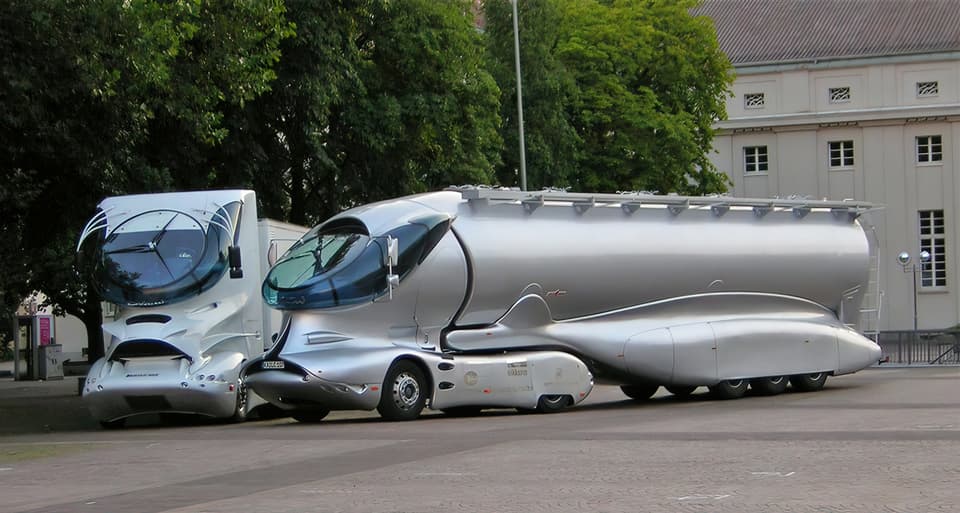
Colani “Space Truck”(Author: Wikipedia-ce, Public Domain, Wikipedia)
Steinwinter Supercargo 20.40
Do you think that the 1.8 m height of the Texaco Doodlebug is small for a commercial vehicle? What would you say about 1.2 meters? And that for a semi-tractor? Impossible? Yet, it is true! Manfred Steinwinter ran a company specializing in tuning Fiat cars. In 1983, he presented a project he had been working on for the past five years. A project so intriguing and –as it seemed at the time –with so much potential that it received support from Mercedes-Benz. We’re talking about the Supercargo 20.40 –a very, very low tractor unit.
Manfred Steinwinter believed that the way to increase the load capacity of a tractor-trailer set was simple: extend the trailer to be able to load more cargo. How to ensure such a combination still complied with regulations regarding maximum permissible length? Steinwinter had an answer for that: just lower the driver’s cab so much that the trailer would end above it, not behind it, as in a typical configuration.
The finished vehicle really looked like something out of a science fiction movie. Its height of nearly 1.2 m was the same as that of sports supercars of that period. Not only this connected the Supercargo 20.40 with Ferrari and Lamborghini models. In the cabin, three sport seats made by Recaro, upholstered in brown leather, were installed. Sitting in such an interior, so low above the road, a truck driver could indeed feel like they were behind the wheel of an Italian supercar. Steinwinter’s tractor was 6.5 meters long and 3.5 meters wide. It was equipped with an eight-cylinder diesel engine by Mercedes and a twelve-speed transmission. Manfred Steinwinter strongly believed in his project (he even planned to develop a tourist coach based on it) and convinced the Mercedes executives to support it, but it soon became clear that the ultra-low tractor unit was another dead end in the development of commercial vehicles. The prototype covered 3000 km during tests, and then all of its flaws and shortcomings became apparent: poor visibility, a tendency to slide, difficult maneuvering, and an uncomfortable position for the driver on longer journeys. Questions were also raised about the passive safety of the construction in the event of an accident.
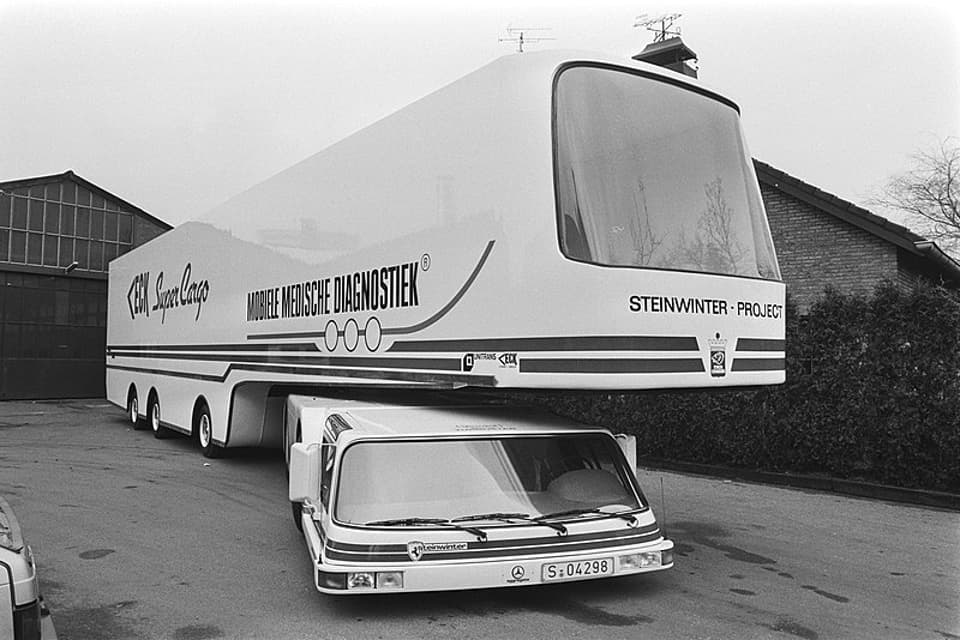
Steinwinter Supercargo 20.40 (Author: Author: Rob Croes for Anefo, CC BY-SA 1.0, Wikipedia)
If you’re looking to transport your goods and want to benefit from the expertise of proven carriers in our network, we’ve got you covered. While it’s true that none of our carriers boast a Colani ‘Space Truck’in their fleet, rest assured they possess the right equipment to meet your needs. Get in touch with us to find out more!